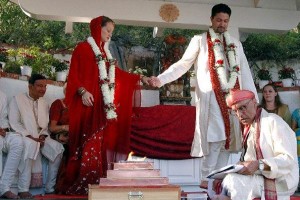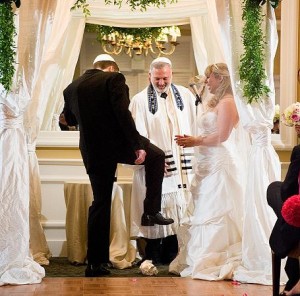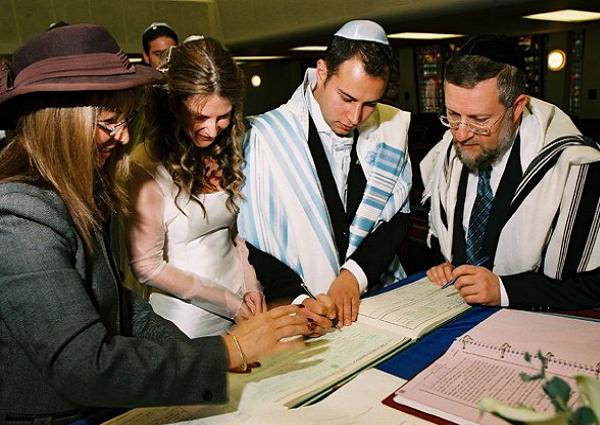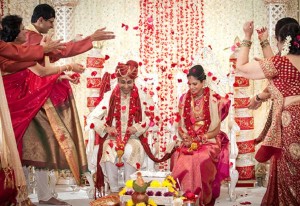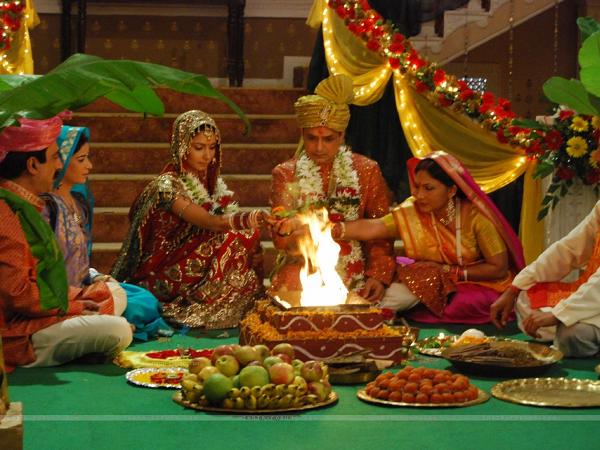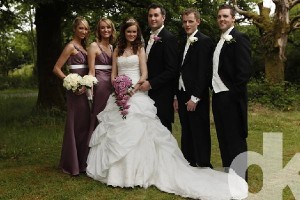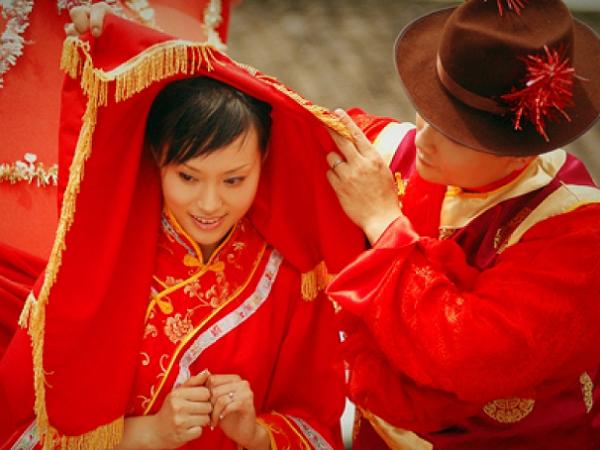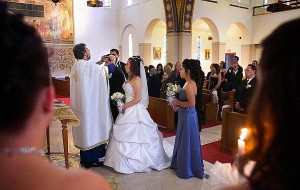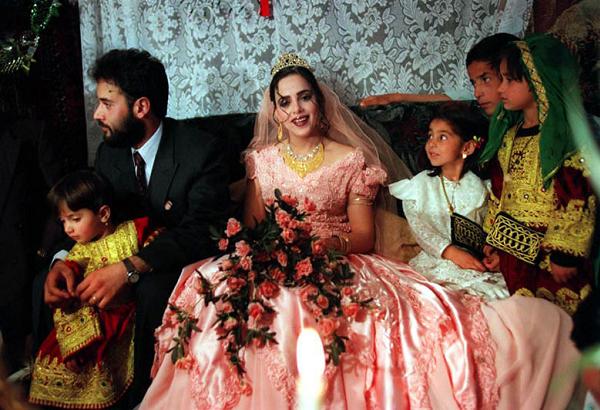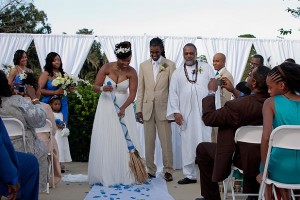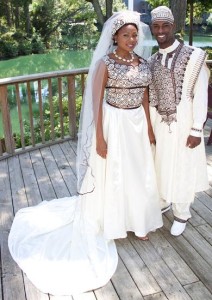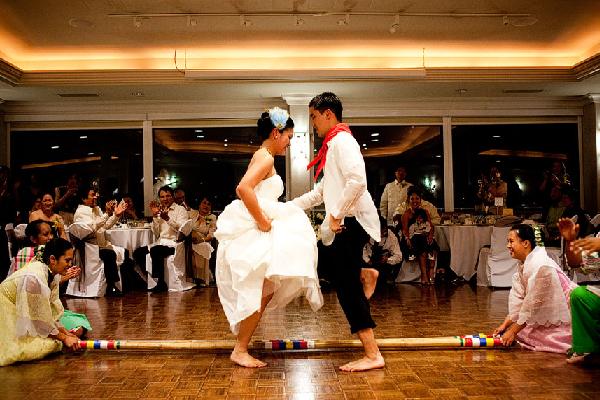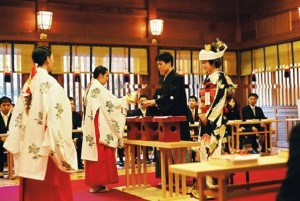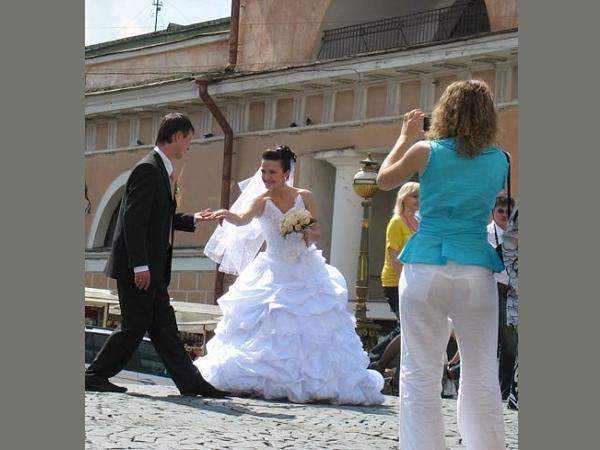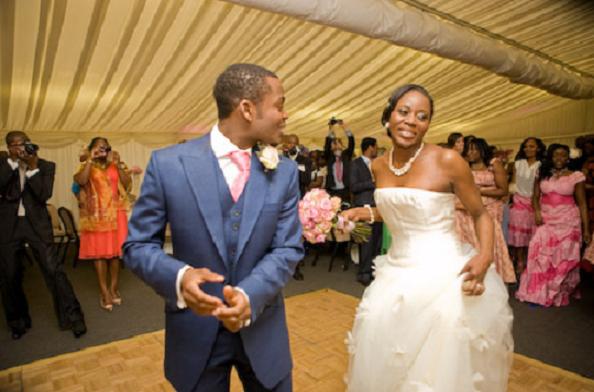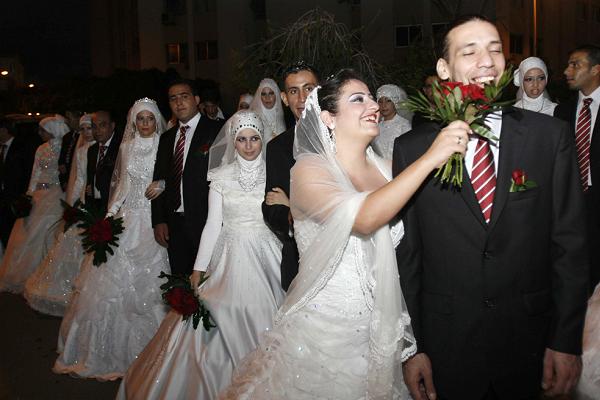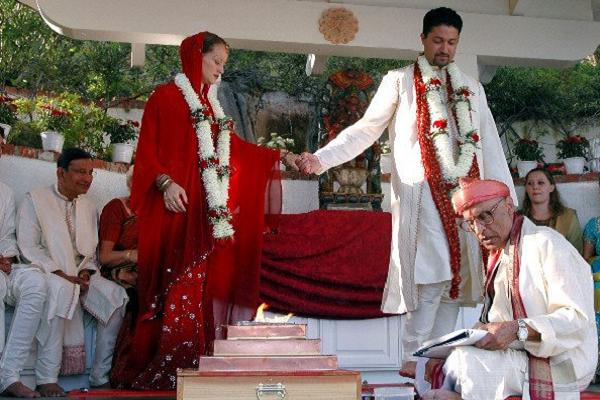
Wedding symbolizes the unison of two bodies and two souls. Weddings are one of the most memorable events in anyone’s life. Marriage not only brings together the man and the woman but also bonds the families of the bride and the groom together. Different communities follow different rituals and traditions during the wedding. Each ritual or traditions have a deep-rooted meaning behind it. Traditions vary in terms of bridal wardrobe, actual wedding ceremony, pre marriage nuptials, post marriage rituals, role of family etc. some traditions may have wedding ceremonies that last for three to seven days whereas in some countries, the wedding ceremony and rituals are completed in a day. In any case, wedding traditions are full of color, fun and joy. Bride and the groom have to undergo series of rituals individually and as a couple. Most of these traditions celebrate the final days of their single lives and prepare them for a forthcoming life as a couple. A look at different wedding traditions around the world also reflects the diversity in the culture. A look at wedding traditions also reveals the cultural and social intricacies of the particular community.
Jewish Wedding Traditions:
Jewish Wedding traditions are historic and fun. The wedding ceremony starts with signing of the ketubah. Ketubah refers to the marriage contract that highlights the responsibility of the groom towards the bride and vice-versa. Two witnesses along with the bride and the groom sign Ketubah. Bride is veiled by her relatives. After the ketubah is signed, the groom is brought under the wedding canopy by his father and his father-in-law, similarly the bride is led under the canopy (known as chuppah) by her mother and mother-in-law. Under the chuppah, the Jewish groom presents the wedding band or a plain gold ring to his bride in order to initiate the marriage. The bride circles the groom thrice or seven times and then accepts the ring. After the ring is accepted, the groom breaks the wine glass under his foot and everybody raises a toast for the couple. The couple now retreats in to a private room for some time and then joins the guests for wedding reception. Wedding reception involves dance and songs around the couple. The guests shower their blessings on the couple and present them with gifts.
Indian Wedding Traditions:
Indian weddings are full of pomp and joy. The traditional Hindu wedding celebration lasts for three to seven days. Traditionally the Hindu wedding starts with pre-marriage nuptials that involve nav graha puja, which is performed individually at bride and groom’s house to seek blessings of the nine planets. After Navgraha puja, the bride’s mother hosts a Mehndi ceremony where the hands and feet of the bride are adorned in henna. A professional Mehndi artist applies intricate Mehndi designs or simple Arabic Mehndi designs on the hands and feet of the bride. Haldi ceremony follows the Mehndi night where turmeric paste is applied to bride’s body in order to bring glow to her skin. Wedding rituals include honoring the groom, kanyadaan and the saat pheras. Kanyadaan ceremony refers to ritual where bride’s father offers bride’s hand to the groom. The couple then circle the holy fire 7 times as the recite their wedding vows. After the saat pheras, the couple meets the guests and share food with them. Bride bids a tearful goodbye to her parents and moves to her new dwelling. She returns to her mother’s house on the fourth day of the wedding and the groom comes to take her back to his house on the fifth day. This ceremony is called the path phera.
Irish Wedding Traditions:
Irish wedding traditions are starkly in contrast with most of the wedding traditions across the world. The Irish bride wears a claddah ring for her wedding, claddah rings are handed from one generation to another, the bagpipe band accompanies the bride and the groom to the church, hearing a cuckoo on the wedding day is considered auspicious as per the Irish customs. Irish lace is incorporated in the wedding outfits and the colors of green, white and gold are the colors of wedding couture. The couple exchanges the wedding vows while the relatives lock the doors of the church. Post wedding the couple drinks mead and the guests raise a toast to them. The bride and the groom break into the traditional Irish dance Ceilidh. The guests accompany them gradually. The couple is then given a month’s supply for mead for their honeymoon.
Image Courtesy: rishweddingphotography.com
Chinese Wedding Traditions
Chinese weddings are subtle and full of rituals. Weddings are often materialized through a previous arrangement between the families. Groom’s family will approach the matchmaker and send their proposal through him to the bride. After the acceptance of proposal, the matchmaker will match the groom and the bride’s birth dates to determine their marriage prospects. This is known as Suan Ming. After Suan Ming, the groom’s family sends the Betrothal letter and Bride price through the matchmaker. Bride Price includes jewelry, clothes, incense etc. Wedding date is then finalized by consulting the Chinese calendar. The wedding procession consisting of musicians, band parties and relatives accompany the bride and the bridesmaids to the wedding venue. The couple seeks blessings from the Bodhisattvas, Buddhas and their elders. The couple then hosts a wedding banquet that consists of an elaborate ten-course menu. Bride presents tea or wine to her in laws and the guests present at the wedding. Chinese brides wear three different dresses on their wedding day; the first is the traditional red or white Chinese wedding dress, second is the white gown and third is a cocktail dress of the bride’s choice.
Greek Wedding Traditions:
After the groom’s proposal is accepted by the bride’s family, a date for engagement is set. Priest blesses the rings and the couple wears the ring on their left hands till their wedding day. on the day of the wedding, the rings are blessed again and the couple switches the rings to the left hand. Groom and his attendant prepare for the wedding ceremony as the band plays traditional greek music, this is known as Koumparo. The bride and the groom wear the wedding crowns, which are connected with a single pair of ribbon signifying their unison. As soon as the wedding commences, the guests are offered candied almonds covered in a Tulle. Bride’s mother then offers the Dowry to the bride. Dowry consists of all the items that are required by the bride to set up the house. Bride and the groom then break into the wedding dance known as Isaiah. They also join another dance known as Kaslamantiano where the couple dances in the centre of the circle formed by the guests. Kaslamantiano is performed at the reception. After the feast, local girls help the bride to set up her new house, this process is known as the Nyphostoli.
image Courtesy:groupof10.com/
Afghan Wedding Traditions:
Nikaah is conducted by the Mullah in presence of bride’s representative and the groom, after bride’s acceptance, the couple join the guest. Simple Arabic Mehndi designs are applied on the couple’s hands after they recite holy verses and feed each other with Malida.
African American Wedding Tradition:
African American couples imbibe their heritage in their church marriages. They represent their unison by asking the attendant to tie their wrists together with a strand of Cowrie shells or a piece of Kentee cloth.
African Wedding Tradition
African weddings are elaborate and colorful. This includes the Yoruba ritual where the couple tastes four elements of food signifying the variety of emotions in married life. They also jump over the broom together to signify their marriage.
Albanian Wedding traditions:
Albanian weddings are full of pomp and extravaganza. There are around 14-15 bridesmaids for the couple. The couple and their parents arrive in limos and the wedding is conducted in church. Guests leave money in the envelope as a wedding gift to the couple. Albanian weddings are one of the most expensive weddings.
American Wedding Traditions:
American weddings have the concept of bridesmaid and the best man for the bride and the groom. The couple exchanges wedding rings as they say their vows. The couple seals their marriage with a kiss. The couple then joins the Ballroom for a special dance.
Armenian Wedding Traditions
on a night prior to the wedding day, the groom’s family will bring in the bride’s shoes, veil and wedding dress. She will circle her veil over her unmarried friends to bring them luck . After the wedding is solemnized, the guests throw coins on the couple as they release a dove in the air.
Filipino Wedding Traditions
The groom presents the bride with 13 pieces of gold as his pledge to her welfare and their children’s welfare. They light a unity candle to invoke the blessings of Christ. Bride and the groom are clothed in white and white cord is draped across their shoulders to signify their unison.
Italian Wedding Traditions
the bride and groom are tested for their marriage skills on the route to the church by placing a crying baby, fallen broom etc in their way. Groom’s tie is cut into pieces at the end of the ceremony to pay for the band. Guests are served 14 course menu.
Japanese wedding traditions
the bride and the groom and their parents drink Sake from three cups thrice in order to signify them as couples and then to signify three human flaws and three human virtues. Brides wear a white kimono for the wedding.
Korean Wedding Traditions: The bride and the groom dress up like nobility and drink white wine served in cups made of half gourd. They drink from their individual cups and then mix the wine and drink again as a symbol for their unison.
Vietnamese wedding traditions: Mother in law showers the bride with pink chalk . A procession from groom’s family visits the bride. They exchange vows and the groom’s family dresses the bride in new jewels. A 7-10 course meal is served to the guests to celebrate the unison.
Swedish Wedding Traditions: The bride carries coins in her shoes; a silver coin in her left and a gold coin in her right as a gift from her parents. The couple marry in the church and the guests raise a toast to them. Banquet consisting of traditional Swedish dishes is served to the guests.
Spanish Wedding traditions: brides dress in black to symbolize devotion till death. The couple wears rings on their right finger. The Marichi Band and Spanish wedding dance follow the reception.
Scottish Wedding Traditions: bride and groom have their respective bachelorette party the previous night. They exchange vows in the church and the groom places a same colored sash on the bride to accept her in to the family.
Asian Wedding Traditions: Asian wedding traditions differ from country to country. All the traditions involve rituals involving a new beginning and honoring the bride and the groom in presence of the divine.
Thai Wedding Traditions: Thai weddings are a private affair and the bride and the groom sit on the floor with their hands folded in a ‘Namaste’ position. They also prepare food for the monks and seek their blessings for fruitful married life.
Turkish Wedding Traditions: Turkish bride visits her mother’s house after exchanging the wedding vows. Her friends and relatives then use henna to apply simple Arabic Mehndi designs on her hand. Wedding rituals can extend up to seven days from the start of proposal ceremony.
Russian wedding traditions
The bride and groom race each other to the red carpet. They recite their vows on red carpet. A two day reception follows the traditional Russian wedding or Russian civil wedding.
Australian Wedding Traditions
the couple exchanges wedding bands to signify their marriage. Most traditions are same as Irish weddings. A keepsake bible is handed to the bride and the groom.
Canadian wedding Traditions: the bride and groom are subjected to humorous and embarrassing stories about themselves as the family members and friends toast for their wedding. The bride wears an old piece of family jewelry, a borrowed item, a new item and also incorporates the color blue in her bridal trousseau.
British Wedding Traditions: the flower girl scatters the flower petals on the way to the church. The bridesmaid and maid of honor accompany the bride whereas the Best man accompanies the groom. Shoes are tied to the newly-weds car as a sign of good luck.
Brazilian Wedding traditions: the groom has to prove his worth by taming the unbridled donkey. The dinner tables are named after Brazilian cities and bride has to arrive late so that the groom has to wait for her.
Pakistani Wedding Traditions: The bride is adorned with Henna comprising of simple Arabic Mehndi designs on a night before marriage. The bride and groom do not see each other until the marriage is solemnized. The couple and their respective fathers sign the nikaahnama in presence of the Maulvi.
Buddhist wedding traditions: weddings can be conducted in temple or in a civil ceremony format. The married couple seeks blessings from the monks. There is no specification about the wedding attire. It has to be modest and should not be too revealing.
Catholic wedding traditions: couple weds in the church in presence of the priest. They exchange rings at the end of the ceremony. A grand reception follows the wedding.
Christian Wedding traditions: Christian Wedding comprises of the wedding procession, exchanging of marriage vows and wedding bands followed by traditional dance and reception.
Muslim Wedding Traditions: Bride and the groom sign the nikaahnama in presence of Kazi. Bride is adorned with beautiful and simple Arabic Mehndi designs.
Hindu Wedding Traditions: Couple circles the holy fire seven times as they exchange their marriage vows. A string of pre-nuptial and post-nuptial ceremonies form a part of Hindu wedding.
Islamic Wedding Traditions: Islamic Wedding consist of Mehndi ki raat, Nikaahnama, Ruksat and Daavat. Simple Arabic Mehndi designs are used to decorate the bride. Islamic weddings last for three days.
Sikh Wedding Traditions: Sikh marriage ceremony is held in Gurudwara. The groom carries the sword of honor. Bride and the groom recite verses from guru granth sahib. A grand reception follows the wedding.
Celtic wedding traditions: Celtic Weddings include wedding cake, exchange of rings, bagpipes, dance and feast. The marriage is a merry making event and people enjoy it to the fullest.
Columbian Wedding Traditions: after the ring ceremony, the couple lights a single candle to symbolize their unity. This is the most important wedding ritual in Columbia.
Mexican Wedding Tradition: The bride leaves a bouquet of flowers at the foot of Virgin Mary’s statue and seeks her blessing. Couple also seeks blessings from the priest.
Jamaican Wedding Traditions: Jamaican weddings involve participation of the entire village. Reception is conducted in booth at groom’s house, made from flowers and boughs.
Cuban Weddings: Friends and relatives dance along the wedding procession. Men at the wedding indulge in money dance at the wedding.
German Wedding Traditions: German wedding lasts for three days. The guests break old plates at the reception to bring in good luck to the newly-weds.
Norwegian Wedding Tradition: bride and groom wear traditional Norwegian clothes,. Wedding cake made from bread, cheese and syrup is distributed to guests after the wedding.
Welsh Wedding Tradition: the groom carves a wooden spoon and presents it to the bride. The bride is kidnapped by her family and groom and his friends should rescue her in good spirit.
Punjabi Wedding Traditions are much similar to Hindu traditions where couple exchanges vows in presence of ceremonial fire. Mehndi, Haldi and Sangeet are essential parts of the wedding.
Danish Wedding Traditions: guests throw rice on the newlyweds as they step out of the church. Sumptuous feast is served to celebrate unison.
Dutch Wedding traditions: party is hosted before exchanging the vows, the bride and the groom sit on the throne throughout the ceremony.
French Wedding traditions: the groom invites bride to his house on the wedding morning and escorts her to the Chapel. Couple walks on path strewn with flowers.
Puerto Rican Wedding traditions: the couple’s fathers escort the bride and the groom to the ceremony. Best Man is not part of the Puerto Rican wedding. Reception is sumptuous and full of music.
Egyptian wedding tradition: Musical March termed Zaffa starts just before the couple exchanges wedding vows. Weddings are conducted in traditional manner.
English wedding traditions: Wedding bands, Bridesmaid, Best man and fruit cakes are the order of the day for English Weddings. They are organized similar to catholic weddings.
Hawaiian Wedding tradition: bride and the groom are dressed in flower leis and they exchange wedding bands with their names engraved on it.
Hispanic Wedding Tradition: Hispanic weddings are fully spiritual and couple kneels down for their prayers during the mass.
Hungarian Wedding Tradition: guests break plates on the floor and toss handful of coins in it. Bride has to separate the pieces of plates from the coins with a broom. Reception is grand and couple thanks each guest personally.
Moroccan Wedding Traditions: wedding is a four day event like Muslim weddings. Simple Arabic Mehndi designs are applied on bride’s hand on her wedding morning.
Native American wedding traditions: bride and the groom must wash their hands before marriage to cleanse off the evil.
Nigerian Wedding Traditions:
the elders negotiate bride price and then the official marriage ceremony follows. It is full of fun and color.
Pagan Wedding Traditions:
pagan weddings integrate nature in every aspect. The bride and the groom stand in the circle to say their vows.
Persian Wedding traditions: most of the traditions fall in the Zoroastrian segment. Signing of Aghd is essential to conduct a Persian wedding.
Polish: parents gift the couple bread, salt and wine. The bridal veil is removed as she enters the church.
Portuguese Wedding Traditions: the couple is showered with candies as they step out of the church. Priest places his stole on the couple as they exchange vows.
Romanian: Romanian guests throw candies and nuts at the newly-wed couple.
Ukrainian Wedding traditions : traditional bread called Karovai substitutes the wedding cake at Ukrainian wedding
Serbian: the groom needs to shoot the apple placed on a sick with the rifle to prove his capability to get the girl.
Lebanese Wedding Traditions:
Lebanese weddings are full of pomp and show. Traditional dance called Zaffa is performed at Lebanese weddings.
Southern Wedding Traditions: southern style weddings are conducted mostly in outdoor. They are rich and cultural in nature.
Strange Wedding Traditions: from breaking the glass to breaking the bulb, different countries follow strange wedding traditions.
Wedding cake traditions: wedding cakes can be of different shapes and different tiers. Traditionally they are fruit based.
Weird Wedding traditions: from kidnapping the bride to jumping the broom, list of weird traditions is endless.
Wedding Anniversary traditions: wedding anniversaries are celebrated with fruitcakes and traditional wedding gifts.
Wedding ceremony traditions: wedding ceremonies can be extravagant and sometimes even strange. Some ceremonies last for four to seven days.
Wedding Reception traditions: Wedding receptions are full of music and dance and are followed by sumptuous feast.
Wedding traditions in America: American weddings are colorful and spiritual. The best man and bridesmaid play important part in ceremony.
World wedding traditions: different countries across the world have different traditions; however, they all signify unison, love and new beginning.





